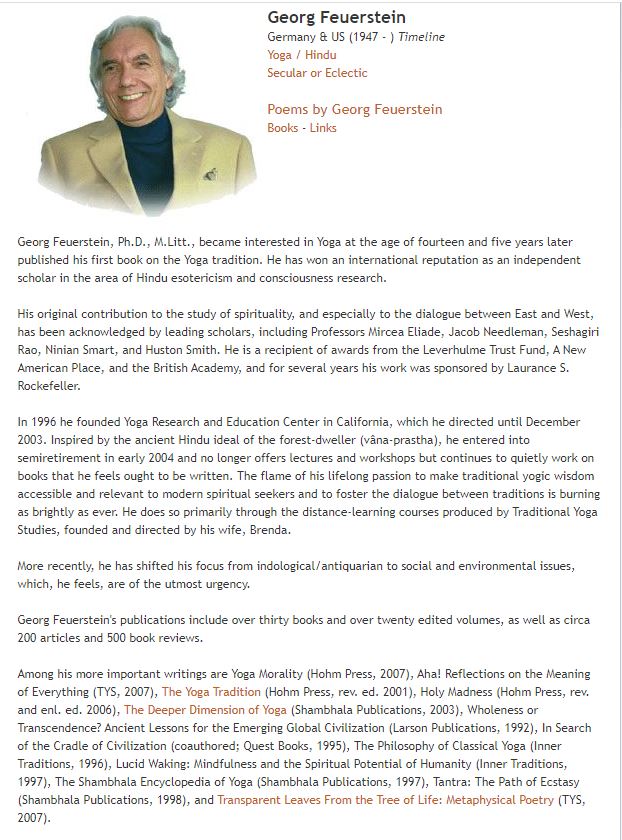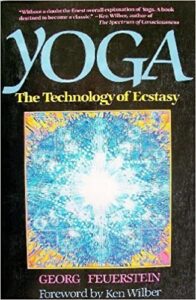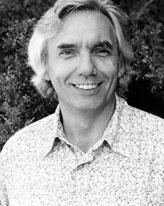Georg Feuerstein
PREFACE
 y first encounter with India’s spiritual heritage occurred at the age of fourteen or fifteen, through the works of Paul Brunton, whom I regard as one of the finest Western mystics of this century.1 Brunton, who died in 1971, ranks among the pioneers of the East-West dialogue, and his writings have been widely influential. I still vividly remember the yearning I experienced when reading about Brunton’s remarkable encounter with Sri Ramana Maharshi, the great sage of Tiruvannamalai in south India, whose spontaneous and effortless enlightenment at the age of sixteen became an archetypal symbol for me. I would gladly have abandoned school, which I found utterly boring, to follow in the footsteps of the great saints and Self-realizers of India.
y first encounter with India’s spiritual heritage occurred at the age of fourteen or fifteen, through the works of Paul Brunton, whom I regard as one of the finest Western mystics of this century.1 Brunton, who died in 1971, ranks among the pioneers of the East-West dialogue, and his writings have been widely influential. I still vividly remember the yearning I experienced when reading about Brunton’s remarkable encounter with Sri Ramana Maharshi, the great sage of Tiruvannamalai in south India, whose spontaneous and effortless enlightenment at the age of sixteen became an archetypal symbol for me. I would gladly have abandoned school, which I found utterly boring, to follow in the footsteps of the great saints and Self-realizers of India.
It was in 1965 that I encountered the spirit of India more concretely in the person of a Hindu swami who was making headlines in Europe for his astounding physical feats. He was able to bear the weight of a steamroller on his chest, pull a loaded wagon with his long hair, and stop his pulse at will. While I was duly impressed by these spectacular accomplishments, they fascinated me far less than the secret behind this physical prowess.
I felt mysteriously attracted to this miracle worker with an impressive physique and a great deal of charisma. I found a way to make contact with him and ended up as his disciple, as I had intuited I would. In the year I spent with him at his hermitage in the Black Forest (West Germany), I learned a great deal about Hatha-Yoga but more about self-discipline and persistence. In the middle of winter, he had me move into a sparsely furnished room, without carpet or wallpaper and with a broken window that I was not to repair. In the early morning, I was expected to break the ice in the well and wash myself outdoors. I quickly learned that to keep warm and well, I had to stay active and do a lot of breathing. It was all rather exhilarating.
Step by step I learned about the teacher-disciple relationship, which involves trust, love, and the constant willingness to be tested. I benefited from the wonderful opportunity for self-transcendence this circumstance presents. But later I also experienced its drawbacks. Gradually I discovered that my teacher was not only an accomplished master of Hatha-Yoga but also suffered from an inflated ego—something not unheard-of in yogic circles, as I was to find out.
When I tried to break loose from that close-knit relationship, I learned another invaluable lesson: Psychic powers are a reality to be reckoned with, and some teachers will use them to hold their disciples. Although I had severed my external ties to my teacher, he continued to influence my life through psychic means, which proved most disturbing. Two clairvoyants, who knew nothing about me, independently described his bearded face with strong eyes and prominent nose, saying that he was the cause of a lot of my inner turmoil and physical troubles.
Fortunately, I never suffered the terrible agonies of a fully awakened but misconducted life-force (kundalini), as was the case, for instance, with the late Pandit Gopi Krishna. Nevertheless, I experienced firsthand some of the disturbing side effects of a kundalini that had been tampered with, particularly states of dissociation from the body. It took many years, and the benign help of another spiritual personage, before the link was finally broken and I could get on with my life. Although the experience had been rewarding on the whole, it left me disappointed, and for a good many years I steered clear of any Eastern teachers.
In the meantime I had developed an interest in learning Sanskrit and studying the great religious and philosophical writings of the Hindus in the original. I channeled my frustrated spiritual impulse into a professional career in Indology, especially Yoga research. Occasionally I dabbled with this or that yogic technique and meditative practice. However, not until 1980 did I make a more decisive spiritual gesture again. A series of life crises freed up my attention to ponder the great question Who am I? more seriously.
It was then that I started to scout for practical help with my inner life. I was looking for a competent teacher and a supportive environment. Since 1966 I had enjoyed the spiritual friendship of Irina Tweedie, a Sufi practitioner in England whose invaluable diary has meantime been published, and now I renewed that relationship. She helped me immensely in those days of reorientation, and thanks to her I experienced my first real spiritual breakthroughs. Also, unbeknownst to me, she groomed me for a greater spiritual adventure.
In 1982 I had my first meeting with the American adept Da Free John (Adi Da Samraj), whose teaching had both excited and touched me deeply. This time around, with fifteen years’ worth of learning behind me, it was more difficult to follow my instincts and entrust myself to the spiritual process that had mysteriously come alive in me. Da Free John fitted none of the stereotypes I had come to associate with spiritual teachers. He was not a mild-mannered, gentle sage but, by his own admission, a “wild character” and a “fire.” His Dionysian quality was a shock to the Apollonian tendencies of my mind.
Yet, once I allowed my heart to make a response, this new relationship proved enormously beneficial, opening up vistas of spiritual understanding and experience for me that I had only dreamed of previously. It has also taught me just how demanding and challenging a life of self-transcendence is, especially when it is not lived in the seclusion of forest or cave but in the thick of a culture that places little value on spiritual matters. Now, seven years later, I look back with enormous gratitude for a discipleship that was difficult but also extraordinarily rewarding. Among other things, I was constantly confronted by my tendency to think about spiritual life rather than to engage it in concrete, practical terms. Whereas previously my meditations were more relaxed musings, the spiritual transmission of my teacher added an experiential depth to this process that I knew existed but had almost ceased to hope for. Although my formal pupilage under Da Free John (Adi Da Samraj) came to an end two years ago, I continue to discover the pervasive effects of the “guru-function” in my life, for which I am profoundly grateful.
Over the years, I came to enjoy many different states of consciousness that in the past I had only read and speculated about. Now when I study the ancient Sanskrit scriptures of Yoga, I have a far more bodily sense of the meaning of their teachings and certainly a far greater appreciation of how little Western scholars, myself included, understand of the esoteric processes with which the Yoga writers were thoroughly familiar.
I felt it was necessary to begin this volume with a brief autobiographical note, because even the most “objective” treatment is shot through with personal qualities: I approach the history, philosophy, and psychology of Yoga not as an antiquarian but as someone who has the deepest appreciation for what the Indian spiritual genius has created over the millennia. I have witnessed some of its effectiveness on my own person and in the case of others who were spiritually more adept than I.
I am in basic sympathy with the spiritual traditions of India, which are authentic efforts at transcending the self. My practical experience of them encourages me to assume that their fundamental insights are genuine and worthy of serious consideration. I further maintain that anyone who wishes to disclaim any of these insights or goals must do so on the basis of personal experimentation rather than mere theoretical consideration.
In some cases, however, my own experience and knowledge oblige me to differ from the authorities of Yoga. For instance, I no longer regard the temporary state of unqualified ecstasy (nirvikalpa-samadhi), the flawless mystical merging of subject and object, as the climax of spiritual life. Such states are indeed extraordinary accomplishments, which come more naturally to some people than others, but they are inherently no more spiritual than our everyday awareness.
I have come to believe that what really matters is how we use the perspective gained in such uncommon states in our daily relationship with others and in life in general. As my twenty-one-year-old son put it to me: It all boils down to whether we love or we don’t. I wish I had arrived at this insight when I was his age. The fulcrum of spiritual life is self-transcendence (which can be called “love”) as a constant orientation. As I understand it, self-transcendence is not merely the pursuit of altered states of consciousness. It also implies a constant willingness to be transformed and, in Meister Eckehart’s sense, to be “superformed” by the larger Reality whose existence and benignity is revealed to us in meditative and ecstatic states of awareness.
This volume is the distillate of two decades of scholarly and practical preoccupation with the tradition of Yoga. It has grown out of my earlier and long out-of-print Textbook of Yoga, published in 1975 by Rider & Co., London. I had borrowed three months from my postgraduate research at Durham University to write that book in the summer of 1974. Even though the volume was well received and has since been translated into several languages, I was from the beginning diffident about its many shortcomings, which I saw perhaps more clearly than most readers. Ever since then, I had been waiting for an opportunity to revise and expand the text. Then it became apparent that a completely new book was called for. So, when the present publisher expressed an interest in a comprehensive handbook on Yoga, I jumped at the opportunity —and wrote an entirely new and substantially larger book.
The objective of this volume is to give the lay reader a systematic introduction to the many-faceted phenomenon of Indian spirituality, especially in its Hindu guise, while at the same time summarizing, in broad outlines, what scholarship has discovered about the evolution of Yoga so far. This presentation should enable the reader to grasp and appreciate not only the astonishing complexity of Yoga but also its intricate relationship to other aspects of Indian culture. Inevitably I have had to deal with some rather involved ideas that will be foreign to those who have no background in philosophy, especially Eastern thought. Without watering down anything, I have tried to introduce such ideas in as graduated a fashion as possible.
To facilitate the reader’s access to the wealth of material, I decided to adopt a dual approach, proceeding both by subject (in Part One) and through history (in Part Two). Because this method introduced a small amount of overlap, I have taken pains to furnish cross-references in each section as well as to supply an exhaustive index. In order to add a touch of immediacy, I have included my own translations of numerous passages from the Sanskrit scriptures that are important to a better understanding of different aspects or phases of Yoga. My translations attempt to be as literal as possible, because I believe this is the best way of doing justice to the intentions of the original text. All too often, renderings from the Sanskrit that read smoothly fail to preserve the meaning of the original work.
Originally, I had hoped to include my renderings of several key works of Yoga, such as the Yoga-Sutra of Patanjali, the Goraksha-Paddhati, and the Bhakti-Sutra of Narada. This proved infeasible, however, because it would have swelled this already substantial volume even more. I plan to make my renderings available in a future publication.
For the benefit of the nonspecialist, I have appended a chronology and a short glossary of key terms.
The emphasis throughout this work is on comprehensiveness and intelligibility. While I did my best to give each facet of Yoga a fair hearing depending on its significance in the overall picture, I could treat many issues only to a certain depth, given the purpose and scope of this volume as well as the limited number of pages available. My other publications and the works of other scholars will fill some of the gaps. However, I want to emphasize that our knowledge of the Yoga tradition is still incomplete, in some cases pitifully so. This is particularly true of Tantric Yoga, which has developed an elaborate esoteric technology and symbology.
While this volume is specifically geared toward a lay readership, I believe that its efficiency as an orientational tool also extends to specialists in the history of religion, intellectual history, theology, the study of consciousness, and transpersonal psychology. Obviously, it was not possible to proffer detailed treatments of all the different aspects of the Yoga tradition, but I have endeavored to make my portrayal as balanced as possible. It was not always easy, however, to resist the temptation of providing more detailed explanations of those aspects for which I have a special affinity and which I have studied more closely, such as Classical Yoga and the crazy wisdom tradition.
To write this book was a rewarding experience, because I was able to integrate materials that had been gestating in me for many years and because I was obliged to make my ideas as intelligible as possible, which always forces one to think and write clearly. To what degree I have succeeded in this will be determined by my readers. I hope that they will find this book as enjoyable to read as I have found it to write.
Georg Feuerstein
August 1989
Lake County, California
Georg in Darshan with Adi Da Samraj, 1985
27 May 1947 – 25 August 2012


